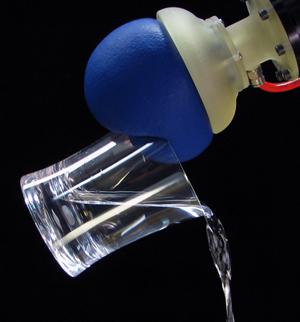
A robot gripper hand, invented by engineers at Cornell University, has inspired some of the same researchers to write an algorithm that can teach any robot how to pick up oddly-shaped objects.
The algorithm allows a robot to learn complex grasping skills by trial and error. The robot can then apply what it has learned in situations it hasn't previously encountered. The researchers said the method is hardware agnostic and will work with any type of robot gripper. This could be especially useful for autonomous industrial robots used in assembly or palletizing lines.
The original "universal jamming gripper" hand was developed in October 2010 by the Cornell Creative Machines Lab headed by Hod Lipson, associate professor of mechanical engineering and computer science. It consists of a large latex balloon filled with a granular material, such as ground coffee. By modulating the air pressure inside the balloon, the granular material can quickly harden or soften to adapt to the object the arm is attempting to grasp.
The new algorithm was developed by Lipson and Ashutosh Saxena, Cornell assistant professor of computer science and a specialist in machine learning. Using the algorithm, a robot employs a 3D image of an object to examine several rectangles that match the size of the gripper. The robot tests each rectangle on a variety of features, and is also trained with images of different objects.
During this process, the robot builds up a library of features that are common to the properties of "good-grasping" rectangles. When the robot is given a new object, it chooses the rectangle that has scored the highest, based on the rules it has developed for good grasping. The robot also considers the overall size and shape of the object to help it choose a stable grasping point.
To test the algorithm, the researchers fitted the jamming gripper and a Microsoft Kinect 3D camera onto an industrial robot arm. The robot was tested in attempts to pick up 23 different objects, including toys, tools, and dishes. In these tests, the robot's success rate averaged 90 percent to 100 percent.
In most cases, the robot arm could successfully grasp new objects that it had not reviewed during its training. When the team ran the same tests with a simple directive to pick up an object at its center, the robot arm scored only had a 30 percent to 50 percent success rate. The exception was in picking up flat objects. With these, both the learned grasps and simple center grasps tied at an 89 percent success rate. The algorithm was also tested with the standard parallel jaws that most modern robots use, which produced similar results.
The team, which includes graduate students Yun Jiang and John Amend, presented their results May 16 in a paper at the International Conference on Robotics and Automation in St. Paul, Minn.
Watch the universal jamming gripper work here.
No comments:
Post a Comment